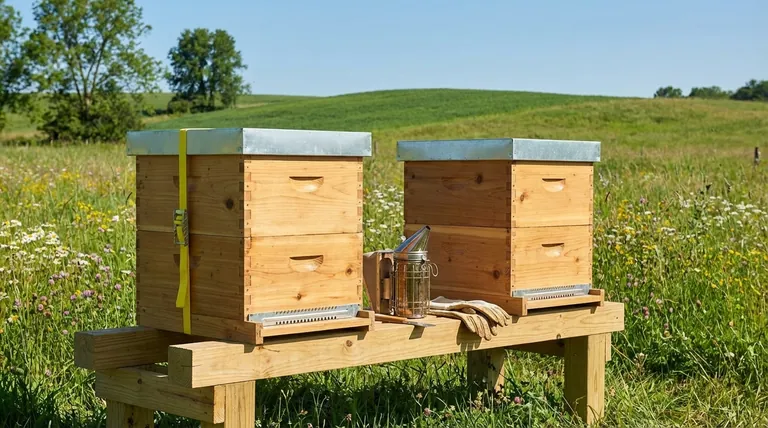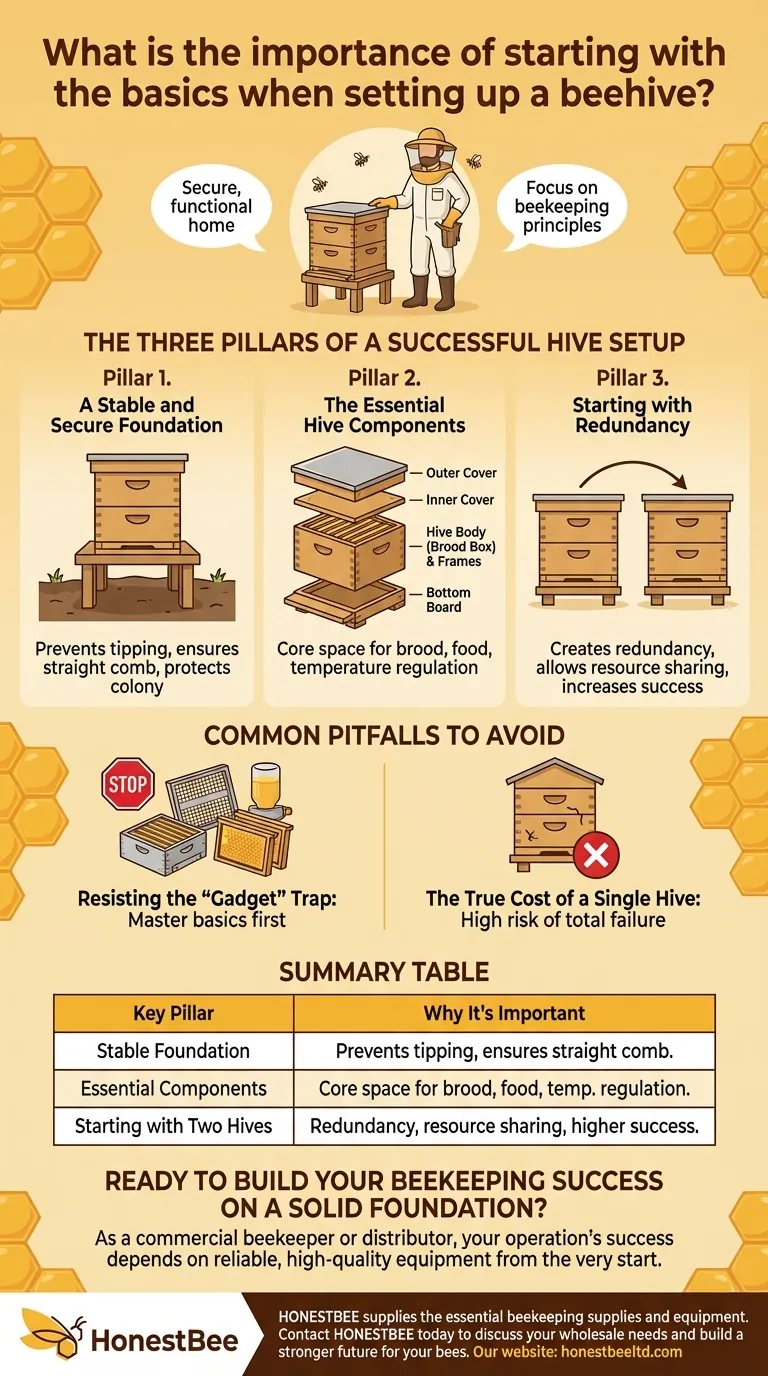To successfully set up a new beehive, starting with the basics is the most direct path to getting your hive operational and ready for your bees. This foundational approach ensures the colony has a secure, functional home from day one, allowing you to focus on learning beekeeping principles before adding complexity.
The core principle is not simply to assemble equipment, but to establish a stable and resource-rich environment. A successful start hinges on three fundamentals: a secure location, essential hive components, and the strategic advantage of beginning with more than one colony.

The Three Pillars of a Successful Hive Setup
A beehive is more than just a box; it's a carefully designed system. Focusing on the core pillars ensures you are meeting the colony's fundamental needs for survival and growth.
Pillar 1: A Stable and Secure Foundation
The physical placement and stability of the hive are non-negotiable. A mistake here can have immediate and severe consequences.
A properly leveled hive stand is the first step. This ensures the entire structure is stable and won't tip over, especially in soft ground or inclement weather. This stability is critical for your safety and for the bees' ability to build straight, manageable comb.
Pillar 2: The Essential Hive Components
While countless accessories are available, a colony only needs a few key parts to function. These include a bottom board, a hive body (or "brood box") with frames and foundation, an inner cover, and a weather-proof outer cover.
This basic configuration provides the essential space for the queen to lay eggs, for workers to store food, and for the colony to regulate its temperature and defend itself.
Pillar 3: Starting with Redundancy
A critical, often overlooked "basic" is to start with at least two hives rather than one. This simple decision dramatically increases your chances of success.
Having a second hive provides a powerful management tool. You can share resources between hives, transferring a frame of eggs or brood from a strong colony to a weaker one, which can be the difference between failure and survival. It also accelerates your learning by allowing you to compare the progress and behavior of two distinct colonies.
Common Pitfalls to Avoid
Your initial focus should be on bee biology and colony health. Many beginners get distracted by equipment, which can complicate the learning process and add unnecessary expense.
Resisting the "Gadget" Trap
Queen excluders, specialized feeders, and ventilated inner covers all have their place, but they are enhancements, not essentials. Adding them too early can obscure the fundamental lessons of bee behavior and hive inspection.
Master the basics of observing your colony's health, identifying brood stages, and managing space before you start optimizing with additional gear.
The True Cost of a Single Hive
While starting with one hive seems cheaper, it carries a much higher risk of total failure. If your single colony fails due to queen issues, disease, or other factors, your beekeeping season is over.
With two hives, one colony acts as a backup and resource bank for the other, creating a robust, self-supporting system.
Making the Right Choice for Your Goal
Your initial setup should directly support your primary goal as a new beekeeper.
- If your primary focus is colony survival: Prioritize starting with two hives on a perfectly level and secure stand to ensure stability and resource sharing.
- If your primary focus is simplicity and learning: Stick to the most basic hive components to master bee biology and hive management without the distraction of extra equipment.
- If your primary focus is long-term success: Combine both approaches by establishing a stable, two-hive apiary with standard equipment as your foundation.
Building a strong foundation from the very beginning is the single most important factor in becoming a successful and confident beekeeper.
Summary Table:
| Key Pillar | Why It's Important |
|---|---|
| Stable Foundation | Prevents hive tipping, ensures straight comb, and protects the colony. |
| Essential Components | Provides the core space for brood, food storage, and temperature regulation. |
| Starting with Two Hives | Creates redundancy, allows resource sharing, and dramatically increases success rates. |
Ready to build your beekeeping success on a solid foundation?
As a commercial beekeeper or distributor, your operation's success depends on reliable, high-quality equipment from the very start. HONESTBEE supplies the essential beekeeping supplies and equipment—from durable hive bodies and frames to leveling stands—that form the cornerstone of a thriving apiary.
Let us help you establish the stable, redundant systems necessary for long-term growth and profitability. Contact HONESTBEE today to discuss your wholesale needs and build a stronger future for your bees.
Visual Guide

Related Products
- Professional Galvanized Hive Strap with Secure Locking Buckle for Beekeeping
- Boardman Entrance Bee Feeder Durable Galvanized Steel and Wood Construction for Beekeeping
- Jenter Queen Rearing Kit Complete Set for Bee Breeding
- Nicot Queen Rearing Kit for Beekeeping and Grafting in Nicot System
- No Grafting Queen Rearing Kit: System for Royal Jelly Production and Queen Rearing
People Also Ask
- What maintenance is required for hive straps? A Guide to Cam Buckle vs. Ratchet Strap Care
- Why are hive straps important for beekeepers? Secure Your Hives Against Wind, Predators & Transport
- What are the two styles of hive straps? Choose the Right Strap for Your Hive Security
- What are the types of Emlocks available? Choose the Right Strap for Hive Security
- What is the best length for straps used around beehives? Why 12 Feet is the Industry Standard



















